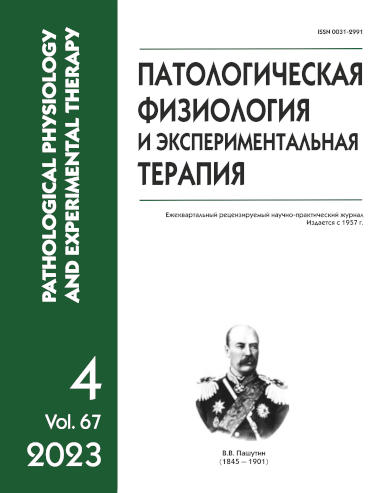The role of disordered hemostasis and humoral immunity in the development of metabolic syndrome in young adults
Abstract
The major pathogenetic mechanisms of metabolic syndrome (MetS) are insulin resistance and visceral adipose tissue dysfunction. The role of changes in hemostasis and systemic cellular and humoral immunity in the progression of abdominal obesity (AO) and the development of MetS has not been studied. Aim: To study the features of hemostasis and humoral immunity in AO and MetS in young adults. Methods. 244 young adults (18-45 years old) with AO and MetS were studied. The patients were divided into 4 groups: group 1 (comparison group), healthy individuals without AO, excessive body weight or additional criteria for MetS (n=71); group 2 (AO), patients with isolated AO (n=32); group 3 (AO+1), patients with AO and one criterion for MetS (n=63); and group 4 (MetS), patients with MetS (n=78). Parameters of platelet hemostasis, coagulation, anticoagulant and fibrinolytic systems, and cytokines concentrations were determined. Statistical analyses were performed. Results. Patients with isolated AO had increased concentrations of fibrinogen and D-dimer and decreased concentrations of the anticoagulant TFPI. Patients of group AO+1 had increased concentrations of fibrinogen, SFMC, D-dimer, and PAI-1 and a prolonged euglobulin clot lysis time. Patients with MetS had increased fibrinogen, PAI-1, SFMC, D-dimer and the anticoagulant TFPI, prolonged fibrinolysis, and inhibited plasminogen activity. Changes in cytokines in all groups were characterized by decreased levels of IL-2, IL-4 and IFN-γ whereas in MetS, these changes were combined with increased levels of IL-6, IL-10, and MCP-1. Conclusions. 1. The activation of coagulation hemostasis was observed in young adults with isolated AO. The progression of AO was associated with inhibition of the fibrinolytic system activity. In young people with AO and MetS, the changes in the anticoagulant potential were evident as decreased TFPI in isolated AO and increased TFPI in MetS. 2. Changes in humoral immunity in young adults were observed already in isolated AO and were manifested by decreased cytokines IL-2, IL-4, and IFN-γ. These changes are also typical for individuals with a combination of AO with one of the MetS components, and in the MetS group they were associated with increased levels of IL-6, IL-10 and MCP-1.






